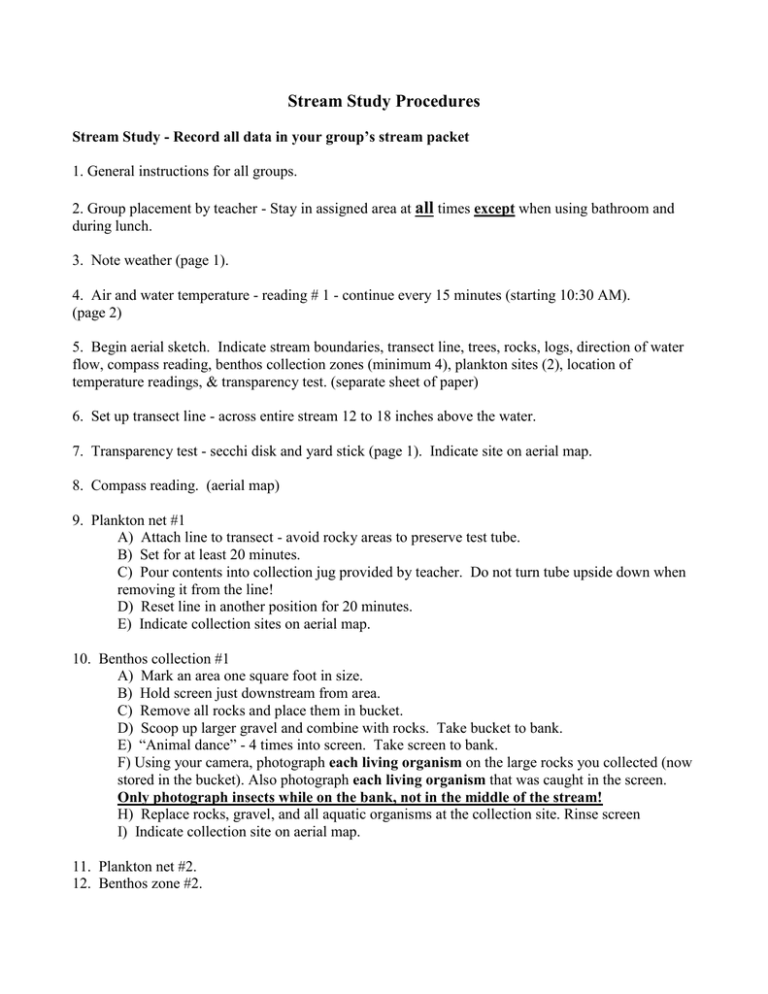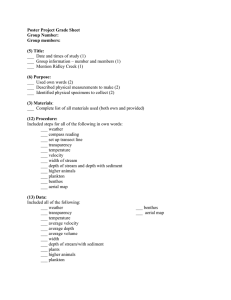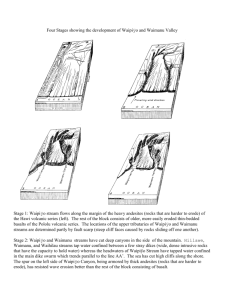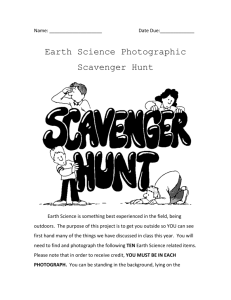Stream Study Procedures all
advertisement

Stream Study Procedures Stream Study - Record all data in your group’s stream packet 1. General instructions for all groups. 2. Group placement by teacher - Stay in assigned area at all times except when using bathroom and during lunch. 3. Note weather (page 1). 4. Air and water temperature - reading # 1 - continue every 15 minutes (starting 10:30 AM). (page 2) 5. Begin aerial sketch. Indicate stream boundaries, transect line, trees, rocks, logs, direction of water flow, compass reading, benthos collection zones (minimum 4), plankton sites (2), location of temperature readings, & transparency test. (separate sheet of paper) 6. Set up transect line - across entire stream 12 to 18 inches above the water. 7. Transparency test - secchi disk and yard stick (page 1). Indicate site on aerial map. 8. Compass reading. (aerial map) 9. Plankton net #1 A) Attach line to transect - avoid rocky areas to preserve test tube. B) Set for at least 20 minutes. C) Pour contents into collection jug provided by teacher. Do not turn tube upside down when removing it from the line! D) Reset line in another position for 20 minutes. E) Indicate collection sites on aerial map. 10. Benthos collection #1 A) Mark an area one square foot in size. B) Hold screen just downstream from area. C) Remove all rocks and place them in bucket. D) Scoop up larger gravel and combine with rocks. Take bucket to bank. E) “Animal dance” - 4 times into screen. Take screen to bank. F) Using your camera, photograph each living organism on the large rocks you collected (now stored in the bucket). Also photograph each living organism that was caught in the screen. Only photograph insects while on the bank, not in the middle of the stream! H) Replace rocks, gravel, and all aquatic organisms at the collection site. Rinse screen I) Indicate collection site on aerial map. 11. Plankton net #2. 12. Benthos zone #2. 13. Benthos zone #3. 14. Benthos zone #4. (If you did not photograph at least 10 different aquatic insects, do a 5th benthos zone.) 15. Width of stream. (page 1) 16. Stream depth and depth of sediment every six inches across stream. If area is greater than 40 feet, do depth every 12 inches. (page 2) 17. Velocity determination. Use watch and tennis ball to calculate time it takes for ball to travel 10 feet. Do 5 sites across stream. (page 1) 18. Record higher organisms (organisms with a backbone or things you did not collect in your jars). (page 4) 19. Complete aerial map. Refer to step 5 for list of what’s needed, including all collection sites. 20. Benthos zone 5 (if needed) to photograph 10 insects. 21. Clean up area. Be sure transect line is taken down, screen is cleaned, and all equipment is collected. 22. You will have approximately 45 minutes (if all other steps have been completed) to change your clothes and eat your lunch. Get ready for return to school at 1:00 PM. Yes, you are going to 7th period!





